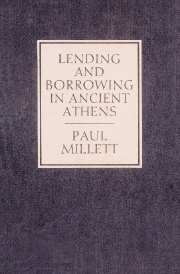Book contents
- Frontmatter
- Contents
- Preface
- I Approaches to lending and borrowing
- II The ideology of lending and borrowing
- III Borrowing and repayment
- IV The rôle of interest
- V Philia and friendship
- VI Non-professional lending: loans without interest
- VII Non-professional lending: loans bearing interest
- VIII Professional money-lending
- IX Conclusion
- Appendices
- Notes
- Bibliography
- Index of passages cited
- Index of papyri
- Index of inscriptions
- General index
- Frontmatter
- Contents
- Preface
- I Approaches to lending and borrowing
- II The ideology of lending and borrowing
- III Borrowing and repayment
- IV The rôle of interest
- V Philia and friendship
- VI Non-professional lending: loans without interest
- VII Non-professional lending: loans bearing interest
- VIII Professional money-lending
- IX Conclusion
- Appendices
- Notes
- Bibliography
- Index of passages cited
- Index of papyri
- Index of inscriptions
- General index
Summary
RECENT WORK ON THE HOROI
Since the appearance of my reassessment of the horoi in 1982 (summarized in SEGxxxiv 158–68), at least three further inscriptions have come to light, of which only one has so far been published.
A limestone plaque from Laureotike in Attica, found in excavations of the Asklepiakon mine at Soureza in 1976–8 (Conophagus 1980: 389 no. 2 ∼ SEGxxxii 236):
This horos (dated to c. 350) is briefly discussed in the text (p. 159, above). The two unpublished horoi are also from the mining area of Attica, from the excavation of a silver-mine site at Agrileza. In his preliminary report, Ellis-Jones records (1984–5: 122) ‘two… boundary stones recording mortgage leases, both using the common oros… pepramenou epi lusei formula; one, with six lines of neat stoichedon lettering of fourth-century b.c. date, came from the washery's SW sedimentation basin, and the other with five lines of less regular letters from alongside the washery.’ The three inscriptions will make a useful addition to the analysis of horoi from the mining area by Lauffer (1979: 89–97).
Several recent publications have a bearing on specific horoi. Whitehead (1986: Appendix 3, no. 58) questions Finley's ascription of a horos pledging property to the Halaieis (1952: no. 5) to Halai Aixonides rather than Halai Araphenides. The horos published as SEGxxx 122 has already appeared in print as SEGxxi 656 (see Chapter vii, n. 8). An inscription identified by Fine as a horos marking property pledged as security to the Thymaitian phratry (1951: no. 11 ∼ Finley 1952: no. 101c) has been convincingly reread by Hedrick (1988) as the boundary-marker of asanctuary.
- Type
- Chapter
- Information
- Lending and Borrowing in Ancient Athens , pp. 222 - 241Publisher: Cambridge University PressPrint publication year: 1991

